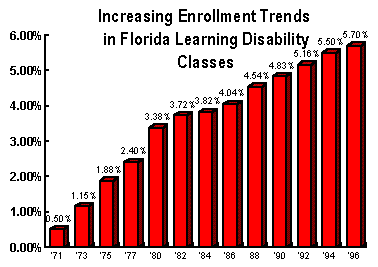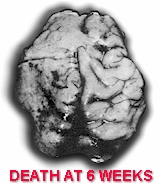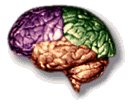click - Environmental Causes Index -
to bypass Learning Disability Crisis Introduction

The Learning Disability
Crisis
As can be seen in the above graph, the
percentage of Florida students diagnosed with learning disabilities has risen from .50%
in 1971 - to 2.40% in 1977 - to 3.38% in 1980 to 4.04%
in 1986 to 5.16% in 1996 and will be over 6% in
1998.
Whereas, the initial increase in these numbers can be explained by
increased identification of children as the new L.D. program began, the continuing
increases seen after 1985 cannot be attributed to this fact. However, there is mounting evidence showing how even low
levels of common environmental chemicals from cosmetics to home pesticides can cause
subtle neurological damage in both laboratory and real life settings.
Types of Neurological Damage found in
Learning Disabilities and Attention Deficit Disorder
Scientists and researchers have now confirmed in a number of
research studies that children with learning disabilities and attention deficit disorder
exhibit at least one of several types of damage to the brain structure. This can
appear as either one or more of the following:
- Fewer numbers of brain cells in important
areas of the brain
- Smaller size of brain cells
- Brain cells that
migrated to the wrong
part of the brain (called dysplasia)
- Lower than normal blood flow to specific
areas of the brain
- Brain cells that metabolize glucose (the
brain's primary fuel) at lower than normal levels
The above provides a neurological explanation for "WHAT"
has actually happened inside the brains of these children, however, it does not address
the question as to "WHY" it has happened. The question of
"WHY" is the focus of this research project.
The Evidence
Some of what you are about to read regarding the causes of learning
disabilities and attention deficit disorder may at first appear surprising, however, all
research included in this web site has been conducted by major medical universities and
research agencies and should therefore, be given careful assessment. It is human
nature to avoid acknowledgment of practices that may have been conducted innocently
for years, but now appear responsible for contributing to neurological harm to our
children. However, continued avoidance of the evidence will only allow the problem
to continue, with obvious negative consequences upon our children, school systems and
society as a whole.
As an explanation for the continued rise in child brain cancers over the past 20-30 years
throughout the U.S., the United States EPA has only recently begun initiatives to form a
research council to investigate the "combined effects" of modern chemicals as an
explanation for the rising rates of brain and neurological cancers among U.S.
children.
Problems in EPA's
Testing Guidelines
Current chemical testing guidelines set by the E.P.A. requires a
chemical company to test a chemical for health effects upon test animals only one
chemical at a time. This, unfortunately, is what many scientists state is a
serious flaw in judging the safety of a chemical because this is not what
our children are exposed to in the real world. In fact, a child is subjected to
hundreds of chemicals simultaneously from chemical flavors and preservatives in food - to
chemicals in cleaning compounds - cosmetics - plastic vapors in carpeting, paints and
upholstery - vehicle exhaust - fabric softeners and chlorine products on bedding while
they sleep and pesticides used in schools and the home. Because of this wide range
of exposure, to determine the potential for true "real-life" effects - it would
be necessary to test all these compounds simultaneously at low level exposures - and this
just isn't being done.
Also, recent information has shown the unborn child is far more
vulnerable to developing neurological damage during pregnancy than previously thought -
the human brain is growing at over 4,000 cells per second beginning in the fourth week of
pregnancy. An increasing number of neurotoxic compounds are being identified in
today's modern society (not present 30-50 years ago) which can weaken or damage this brain
development process. The effects of these chemical exposures can then become evident in
later years as learning disabilities, attention deficit disorders, mental retardation or
personality and behavior difficulties such as shyness, hyperactivity, aggression or even
violent tendencies and lack of conscience.
Also receiving increased documentation is research
showing exposure of the father to various chemical compounds during the 65 days prior to
conception (the time required to complete sperm development in the testicles) can
increase the risk for various birth defects and symptoms common in learning disability
students. The names given to the science which studies this phenomena are Pregnancy Neurotoxicology, Developmental Neurotoxicology and
Behavioral Toxicology and will be addressed below. |





 Topic headings below
detail the primary exposure sources which medical research has found can damage the
delicate brain cell growth process occurring during pregnancy.
This research provides strong evidence to support an environmental explanation for the large
increases being observed nationally in children with attention deficit disorders (A.D.D.),
learning disabilities and other behavior disorders such as hyperactivity, aggressive
disorders and emotional handicaps (EH). The majority of research was compiled from the
University of Florida and University of South Florida Medical Libraries by extensive
investigation through the bound editions of the "Index Medicus" world-wide
journal listings.
Topic headings below
detail the primary exposure sources which medical research has found can damage the
delicate brain cell growth process occurring during pregnancy.
This research provides strong evidence to support an environmental explanation for the large
increases being observed nationally in children with attention deficit disorders (A.D.D.),
learning disabilities and other behavior disorders such as hyperactivity, aggressive
disorders and emotional handicaps (EH). The majority of research was compiled from the
University of Florida and University of South Florida Medical Libraries by extensive
investigation through the bound editions of the "Index Medicus" world-wide
journal listings.















